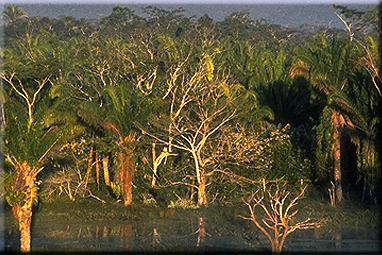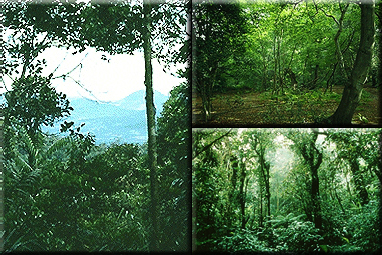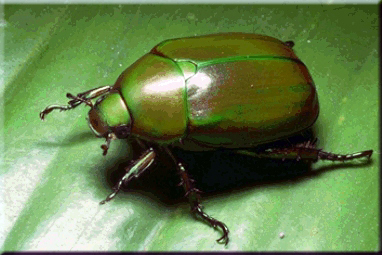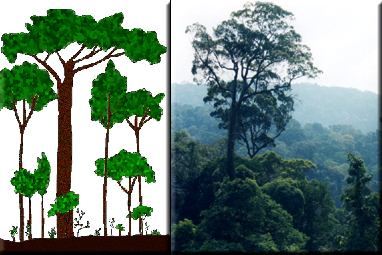|
****JavaScript
web menu drop down DHTML menu generated by NavStudio. (OpenCube Inc.
- http://www.opencube.com)****
|
||||
 Tropical rainforest |
Insects in Tropical Rainforests Various factors may have promoted insect (particularly beetle) diversity in tropical rainforests, most notably:
In fact, the various theories that try to explain high species diversity in tropical rainforests are not mutually exclusive, and may interact over a range of temporal and spatial scales. [Haffer 1997] and [Hill & Hill 2001] provide a review of these current theories. This enormous diversity has been the subject of considerable research effort since the mid-1980s, and is reflected in the many different techniques required to sample insect diversity. |
|||
|
Beetle to Insect Ratios
[Erwin 1982] , based on a fogging study in Panamanian tropical forest, suggested that beetles represent about 40 % of arthropod species found in the forest canopy. Other researchers have come up with lower figures from 7 to 33 % [Southwood, Moran & Kennedy 1982] , [Stork 1988] , [Hammond 1992] .
|
||||
 Forests |
Insect Diversity in Forests [Hammond 1992] reported that a tropical rainforest in Indonesia was five times richer in insect species numbers than a temperate wood in England. The tropical forest yielded 412 beetle species per
|
|||
|
|
Spatial Heterogeneity and Adaptation Tropical rainforests are spatially heterogeneous and offer an enormous range of micro-habitats and micro-climates. The small size, |
|||
|
|
Forest Canopy The forest canopy forms the upper layer of the rainforest, interrupted by occasional emergent trees.
|
|||
|
|
Forest Epiphytes Epiphytes are widespread in on the tree trunks of tropical rainforests.
|
|||
|
|
Forest Understorey The forest understorey is a diverse habitat. The shrub and herb layers provide alternative resources and habitats to the main forest trees. Gaps in the understorey providing yet more habitats for insects. |
|||
 Forest floor in a tropical rainforest in Borneo |
Forest Floor The forest floor provides a range of microhabitats. Leaf litter and soil provide a range of microhabitats for insects. Dead and decaying wood, fungi and other invertebrates provide food
resources for insects. |
|||
|
Motility and Niche Use [Erwin 2001] says that terrestrial arthropods can be found
in
[Erwin 1982] thought twice as many arthropods lived in the canopy compared to other forest layer niches, but other researchers think this figure is too high [Hammond 1992] , [Stork 1988] , [May 1990] . |
||||
|
Predator / Prey Inter-relationships Inter-relationships between With flowering plants and insects, this co-evolution has been both
Co-evolution has also occurred between insect parasitoids and their hosts, and between insect predators and prey. |
||||
 |
Insect and Plant Co-evolution: Phytophagy According to [Farrell 1998] , diversity of beetles is closely related
to that of the angiosperm plants, principally through the great diversity
of
[Hespenheide 2001] questions whether this explanation alone is enough to explain beetle diversity, given the proportion of non-phytophagous beetle groups that exist. |
|||
|
Insect and Plant Co-evolution: Host-specificity Different plant species may support specialised As a result, the high species richness of insects in tropical forests may be a consequence of high plant species richness, the number of insect species found per host plant species, and high levels of host-specificity. What factors might explain tropical insect host-specificity? (See: [Basset 1992] and [Mawdsley & Stork 1997] for suggestions.)
[Erwin 1982] suggested that up to 14 % of beetle species fogged from a single tropical tree were host-specific. However, levels of host-specificity may be highly variable [Mawdsley & Stork 1997] , and lower than Erwin's estimate. [May 1990] and [Stork 1991] suggested 5 % would be a more realistic general figure for host-specificity. |
||||
|
Forest Refugia According to [Haffer 1969] , cyclic patterns of climate change during the Pleistocene brought about fragmentation of the Neotropical forests, creating temporary local "islands" of forest between patches of grassland. These forest islands became refugia for forest species during the drier climate periods, and became temporal centres of endemism, where rapid speciation occurred. During moister periods, when the forests expanded, the refugia also served as centres of dispersal for the forest species. |
||||
|
Research Effort and Biodiversity The provocative estimate of 30 million arthropod species by [Erwin 1982] sparked off a great proliferation in studies of insect diversity in the tropical rainforests, epitomised by [Stork et al. 1997] . It also fuelled a near exponential growth of interest in "biodiversity" as a concept, and in particular the desire to estimate global species richness before the majority of it disappears. |
||||

Methods of sampling insect diversity |
Sampling Insect Diversity
Different insect groups live in See [Basset et al. 1997] for a review on sampling arthropods in tree canopies. |
|||
|
|
||||
 |
Pitfall Traps Ground-dwelling invertebrates are most commonly sampled using pitfall traps sunk into the ground. This technique is particularly effective at collecting beetles and spiders. The trap is normally part-filled with a |
||
 |
Leaf Litter A variety of All work on the principle that insects in these substrates are dependent
on moisture and will move away from |
||
 |
Light traps Many types of Simple light traps comprise a light source behind a suspended white sheet, whilst more elaborate devices use mercury vapour lamps and a collecting chamber.
|
||
 |
Sweep Nets Insects on low-lying This sampling method works particularly well for bugs, beetles, flies, grasshoppers, bees and wasps.
|
||
 |
Flight traps The majority of insects fly upwards when they encounter any sort of obstacle. The Malaise trap exploits this response by funnelling flying insects, in particular flies, wasps and moths, upwards into its tent-like roof and then into a collecting pot. Flight interception traps work on the principle that some flying insects, particularly beetles, drop out of the air when they hit an obstacle. The traps usually comprise a mesh or Perspex screen suspended vertically above collecting trays containing preservative. |
||
 |
Fogging Insecticide fogging is used to collect insects en masse, usually from a single bush or from the tree canopy. A fog of knockdown insecticide envelops the canopy, temporarily stunning all of the insects, making them drop out of the tree. Collecting trays are arranged under the canopy. These collect a sample of the insects which fall from the canopy.
|



